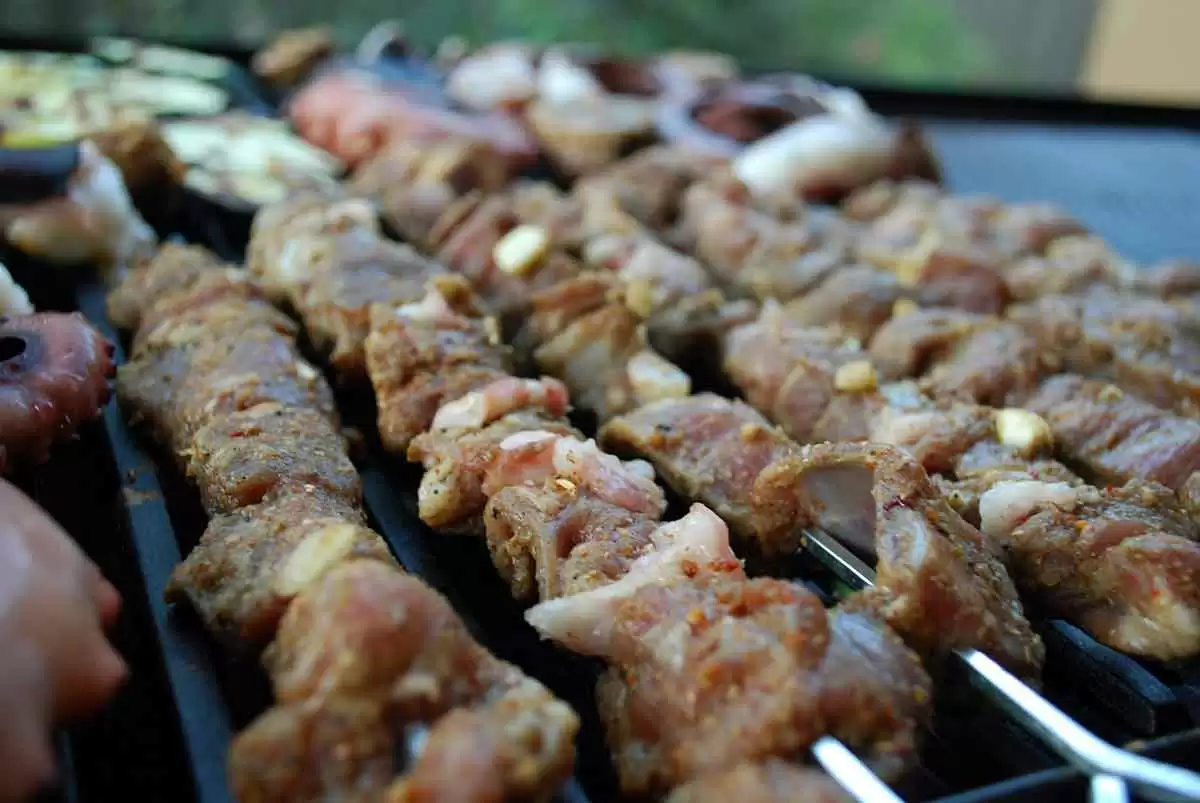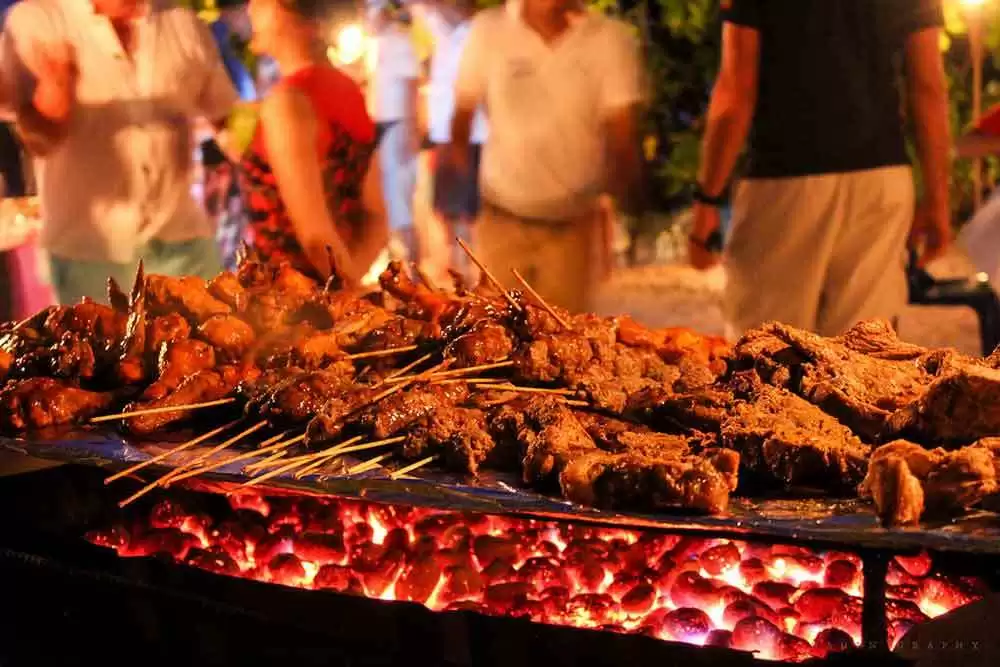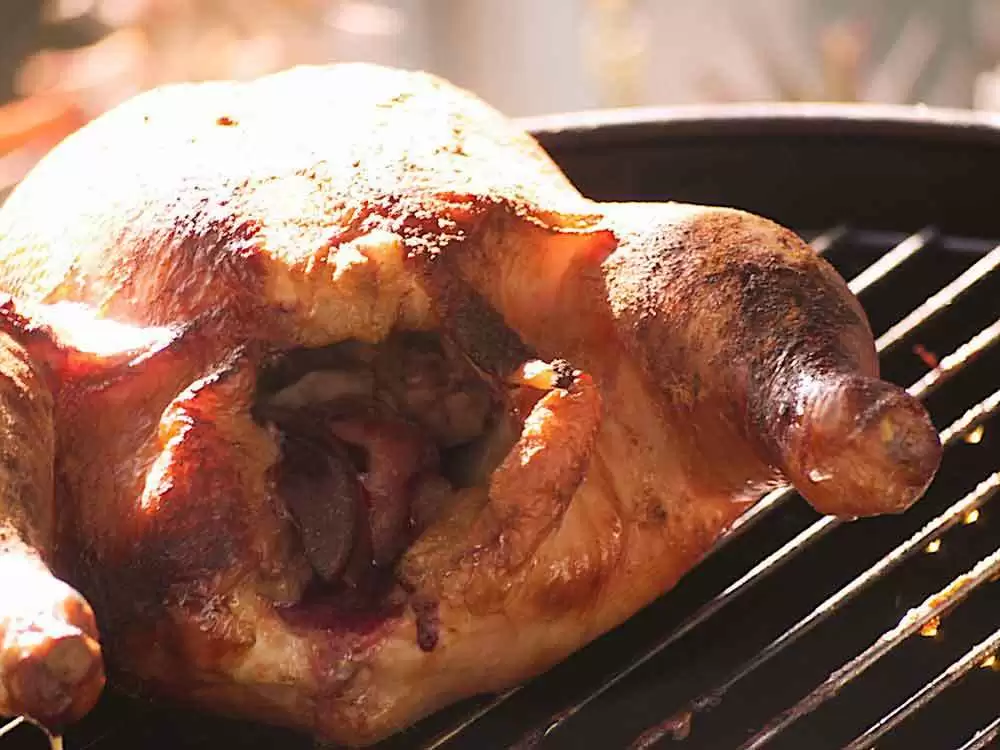
Celiac.com 05/07/2021 - Summer is here and you have more important and fun things to do with your life than stand in a hot kitchen all day cooking. Make the most of your grill.
Take precautions when working with raw meat, poultry and fish. Separate them from ready-to-eat foods during preparation so that raw juices do not come in contact with other foods. If you take them to the grill on a plate, set these foods on a clean plate after they are cooked.
Celiac.com Sponsor (A12):
It’s good to get in the habit of using a meat thermometer when you cook foods on the grill. Cooking the outside of meat or poultry until it bears the famous grill lines is not always an indication that the inside is cooked through. If a meat thermometer reads 160 degrees or more, you can be certain that E. coli and other bacteria have been killed. Poultry should reach 180 degrees.
Mesquite or hickory wood chips (damp) may be added on top of the coals to allow a smoldering effect that provides additional flavor to the food. New to the market is a charcoal made from the husks and shells of coconuts, technically referred to as ‘extruded coconut charcoal’. Coconut charcoal burns hot and clean, imparts a mild flavor, and produces a mild, sweet, but unique smoke.
Do you mostly barbecue or grill? Barbecuing is the slow smoking of tough cuts of meat. Grilling is a method of cooking more tender meats using the direct heat of a fire.
‘Direct heat cooking’ involves placing the food item directly over the flame or coals. Foods are exposed to very hot temperatures, often in excess of 500 degrees. The food items are cooked by flames and infrared heat coming from the grill. The direct heat method is used for grilling steaks, hamburgers, hot dogs, sausage, pork chops and skewered foods. The food items must be turned frequently so as to not burn. When cooking steaks, preheat the grill so the fire is hot enough to sear the outside, sealing in the juices. To judge the heat level of the coals, hold your hand about five inches directly above the grill. If you can hold your hand there for a second, the coals are very hot; for three to four seconds, they’re medium; and for five to six, they’re low.
When using indirect heat, or barbecuing, place the food so that it is not directly over flames or coals. This is done by having the fire or coals on only one section of the grill and placing the food item on a part of the cooking grill opposite the flames or coals. Another method is to block the direct heat to the food item by some means, such as placing the food in a metal pan or on a piece of aluminum foil. This allows the food to cook all the way through without burning or charring on the outside.
Barbecue or Grill Cross-contamination May Be An Issue
If you are warming wheat flour hamburger buns on the grill for non-celiacs, then grill your foods on a piece of foil that has been sprayed with gluten-free nonstick spray. After grilling, clean the grates thoroughly to remove all gluten remnants. The easiest way to clean the grates is to place them in the oven the next time you clean your oven.
Flip Early, Flip Often. This probably goes against everything you’ve heard, but if you want a juicy steak or chicken breast, this technique works. When you put the meat on the grill, there is more heat below the meat than above. The heat forces the liquid up, through the meat. Flip the meat before any liquid has a chance to escape out of the top. The recommended amount of ‘flipping’ is every five minutes. Do not press down on the meat with a spatula during cooking as this will cause the natural juices to seep out.
Rotate. There are different ‘hot spots’ and ‘cooler’ spots on your grill. For foods to cook evenly, rotate the pieces so they each get a chance to be over the hot spots.
Testing for Doneness. This takes practice. Tap the meat with your spatula or tongs. Meat gets less fleshy (less loose) the longer it cooks. With the base of your thumb, feel the center area of the meat gently. Do you feel the difference? With practice, you will be able to tell when the meat is medium, or medium rare, simply by pushing against the meat with the tongs. Basically, the less give there is, the more it’s been cooked.
Though grilling gives you juicy, smoky meat, sometimes you want to add a little flavor to the mix. Do it with rubs and marinades, both of which add both flavor and tenderness. Rubs are dry spice blends, usually including salt and sugar. Rub them on meat immediately before cooking (which adds mild flavor) or do it a day or two in advance (which allows the spice flavor to penetrate deeper inside the meat). Marinades are liquid, and may be made with something acidic (like lemon juice, vinegar, or yogurt) or tropical fruit (like papayas, pineapples or kiwi). Both acids and the enzymes found in tropical fruit react with meat proteins to tenderize. To keep food from becoming over-tenderized (mushy), it’s important not to marinate for too long; as little as 15 minutes for seafood, 4 to 6 hours for thin cuts of meat, and up to 12 hours for larger ones. For minimal mess, use a re-sealable plastic bag—put all ingredients inside, seal it up, and shake to combine. Keep the bag refrigerated while the food inside marinates. Do not reuse marinades—if you want to make a sauce out of the leftover marinade, boil it for at least two minutes before using. Do this to kill any bacteria from the raw meat, poultry or fish.
If you will be adding a barbecue sauce, don’t brush it on too early or the meat will blacken on the outside and still be raw on the inside. Barbecue sauces contain sugar and sugar burns quickly over direct heat. If you think it will take 30 minutes to cook chicken on the grill, cook the poultry 20 minutes before brushing on the sauce.
Think out of the box…think skewers…so many foods lend themselves to being cut into small portions and skewered, like salmon cubes with artichoke hearts, gluten-free kielbasa chunks with green peppers and onions, teriyaki chicken breast cubes with pineapple and green pepper, or shrimp and scallops with red peppers and zucchini rounds.
When grilling a larger portion of fish, be very careful not to overcook it or it will become tough. For soft, flaky fish, a grilling basket works very well, or you can grill the fish on top of a piece of greased, heavy duty foil.
Fajitas are a perfect choice for the grill. Marinate a piece of flank steak for about 3 hours (or longer), cook it on the grill. When done to your preference, take it off the heat; let it rest for 5 minutes then slice it against the grain. Using a pan with holes on the bottom (designed for use on a grill) quickly grill onions and green peppers. Wrap it all up in a gluten-free tortilla… yum!
Other ‘out-of-the-box’ suggestions for grilled foods include marinated asparagus and tomato slices, seasoned potato wedges, prime rib, Hawaiian pork tenderloin, honey mustard chicken thighs, marinated leg of lamb, seasoned calamari… many of the foods you love to eat may be adapted to the grill.
And don’t waste those hot coals! Grill your dessert! Summer fruits are fabulous grilled, as are gluten-free sponge cake and tortilla dessert wraps. Skewer bananas and marshmallows (don’t let marshmallows actually touch the grates) then set out bowls of hot fudge and caramel sauce for dipping.
This summer, turn off the oven, get out of the kitchen, and enjoy grilling outdoors!
Gluten-Free Skewered Scallops
From the “Wheat-free Gluten-free Recipes for Special Diets” Cookbook.
This recipe is gluten-free, corn-free, diary-free, egg-free, peanut and tree nut free, and yeast-free. It is approved for diabetics and it is low in sodium.
For vegetarian and vegan diets: Use 2 cans (15 oz. each) artichoke hearts in place of the scallops.
Ingredients:
- 2 Tbsp. olive oil
- ¼ cup lemon juice
- 2 cloves garlic, minced
- 1 tsp. oregano
- ¼ tsp. pepper
- 1/8 tsp. salt
- ¼ tsp. dill
- 1 lb. bay scallops
- ½ lb. baby mushroom caps
- 2 small zucchini, but into ½-inch slices
- 2 small onions, but into wedges
- ½ red bell pepper, cut into bite-sized pieces
Directions:
In a shallow dish, whisk together the first 7 ingredients. Stir in scallops; cover; refrigerate for 2 hours, stirring occasionally. Preheat grill and spray grates with gluten-free nonstick spray. Thread scallops onto 5 skewers alternately with vegetables. Grill about 5 minutes, turning frequently, until scallops are opaque. Serves 5.
Note: Remove scallops from grill as soon as they are cooked through. Overcooking will cause them to become tough.
Bonus Marinade: Put one package of chicken into a glass bowl, then start the marinade in a large Pyrex measuring cup. You’ll have two liquids: soy sauce, and Worcestershire sauce, and the ratio is 2:1. I start with one cup of soy sauce and 1/2 cup Worcestershire. Next add 1 tablespoon brown sugar, 2 tsp minced garlic, 1 tsp pepper, 1/2 tsp rubbed basil, 1/2 tsp rubbed oregano. Mix everything well (still in the measuring cup) and pour over the chicken. Repeat, if necessary.








Recommended Comments
There are no comments to display.
Create an account or sign in to comment
You need to be a member in order to leave a comment
Create an account
Sign up for a new account in our community. It's easy!
Register a new accountSign in
Already have an account? Sign in here.
Sign In Now